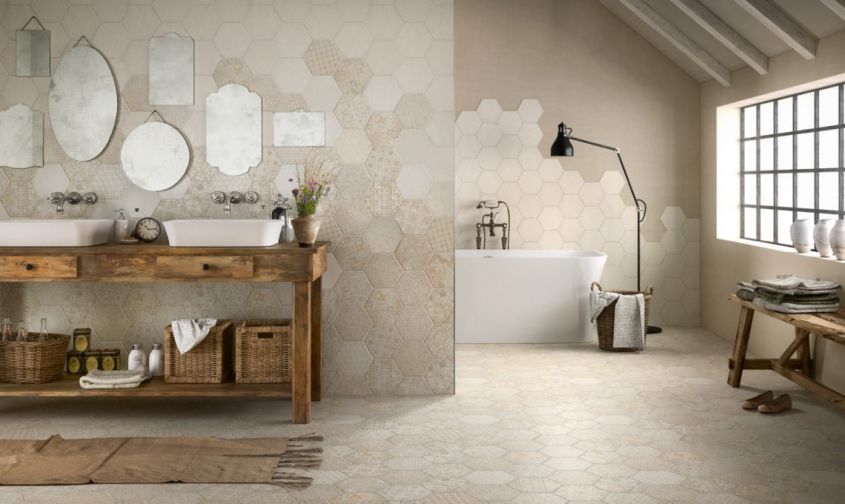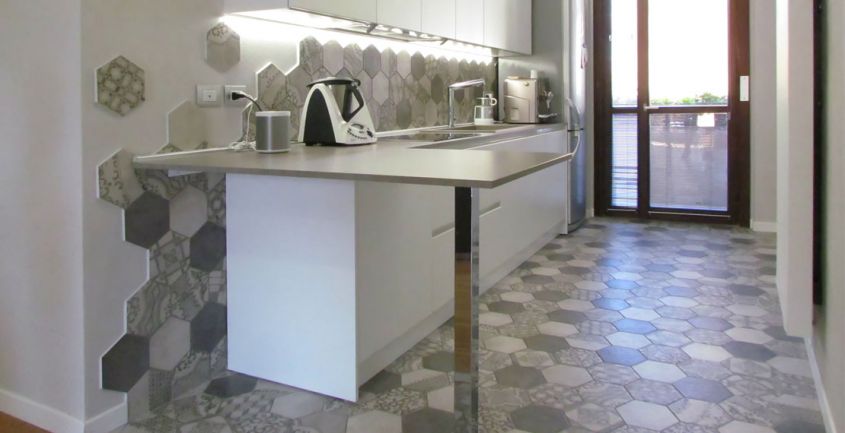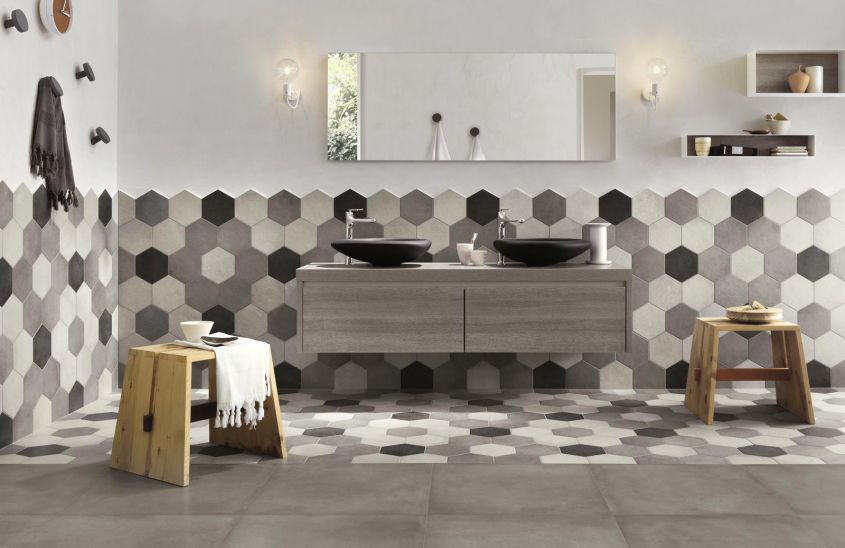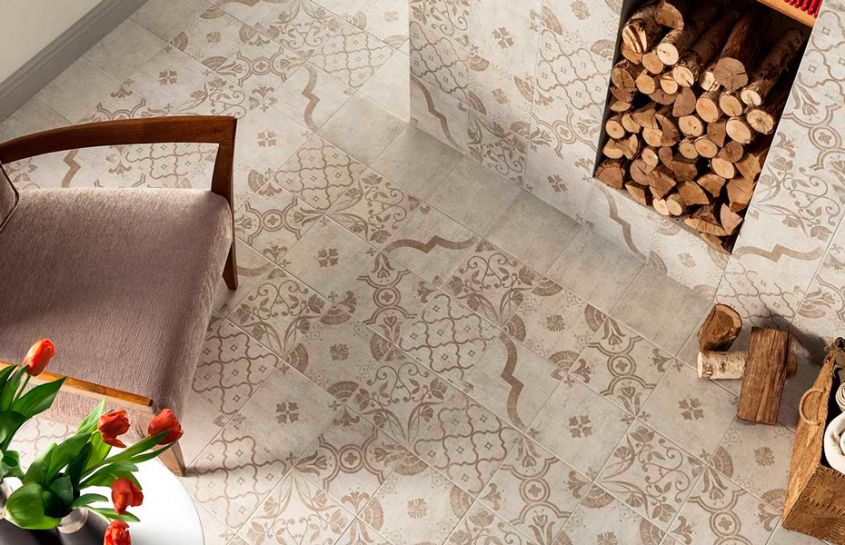The cement tiles for floors I’m the retro trend that is conquering all rooms in the house. The square or hexagonal tiles produced with a cement-based mixture and decorated with geometric or floral motifs date back to the end of the 19th century and today they are experiencing a second youth. Once used to decorate the floors of noble palaces, the cement tiles in the present are chosen to give prestige also to those inside apartments, offices and shops. And for those who are afraid that they are delicate, the companies have thought of the version of cement tiles in the most resistant porcelain stoneware.
We are seeing them in the current catalogs both with their specific characteristics of the dough and revised thanks to a new technical-production process, but their particular decoration remains unchanged over time. The cement tiles are back as tiles to cover the floors with their refined allure, dressing every room of the house with very special vintage effects.
Cementine floors, how and when to choose them
 Samson floor cement tiles
Samson floor cement tiles
The original cement tiles are composed of a mixture of water and white cement to which marble and hard mineral dust is also added, as well as natural dyes. This type of tile has a thickness of about 2 cm and their irregularity testifies to their craftsmanship and distinguishes them from industrial products.
In fact, there are also cement tiles produced following today’s technologies and new materials which, however, have the advantage of being able to count on reduced thicknesses.
Whether you choose the traditional cement tiles or the current version, they allow you to obtain refined decorative effects that immediately bring to mind ancient floors.
Cement tile floors are therefore the ideal choice for a variety of destinations, using them either as a limited carpet decoration or to cover the whole area for a truly suggestive effect.
However, the foresight remains that of preferring stoneware cement tiles for environments such as the bathroom as traditional tiles are very absorbent and could be damaged by stains even from simple water.
Floors with hexagonal cement tiles
 Cement tiles for floors by Iperceramica
Cement tiles for floors by Iperceramica
The classic shapes of the cement tiles are square or hexagonal and the latter offer extremely interesting creative possibilities.
Solid color or characterized by classic geometric decorations and optical patterns, the hexagonal cement tiles can give any surface that touch of retro chic that recalls the old noble glories.
 Hexagonal cement tiles by Marazzi
Hexagonal cement tiles by Marazzi
An example of hexagonal cement tiles for the kitchen is the Clays line by Marazzi in stoneware, a tile that can be installed both on the floor and on the wall.
 Hexagonal cement tiles by Ragno
Hexagonal cement tiles by Ragno
Ragno, on the other hand, has hexagonal cement tiles for the bathroom in porcelain stoneware that reinterpret the materiality of the original ones in a modern key.
How to maintain and restore old cement tiles
 Cement tiles for floors by Antichi Manufatti
Cement tiles for floors by Antichi Manufatti
The old cement tiles are a product to be saved because they are to be considered a real vintage decorative object. The beauty of their polychrome designs, the quality of the mixture and the craftsmanship with which they are produced has in fact become highly sought after especially to be combined with other floors.
The cement tile floors were not sanded or polished, but only treated with linseed oil to make them water-oil repellent and protect them from stains.
To keep them, they must be cleaned well with specific products, taking care not to use acids or smoothing machinery so as not to ruin the decoration and colors, and then proceed to restore at least 2 coats of oil to restore their vigor, and as a finish they can be protected with a coat of liquid wax.
The cement tiles for floors I’m the retro trend that is conquering all rooms in the house. The square or hexagonal tiles produced with a cement-based mixture and decorated with geometric or floral motifs date back to the end of the 19th century and today they are experiencing a second youth. Once used to decorate the floors of noble palaces, the cement tiles in the present are chosen to give prestige also to those inside apartments, offices and shops. And for those who are afraid that they are delicate, the companies have thought of the version of cement tiles in the most resistant porcelain stoneware.
We are seeing them in the current catalogs both with their specific characteristics of the dough and revised thanks to a new technical-production process, but their particular decoration remains unchanged over time. The cement tiles are back as tiles to cover the floors with their refined allure, dressing every room of the house with very special vintage effects.
Cementine floors, how and when to choose them
 Samson floor cement tiles
Samson floor cement tiles
The original cement tiles are composed of a mixture of water and white cement to which marble and hard mineral dust is also added, as well as natural dyes. This type of tile has a thickness of about 2 cm and their irregularity testifies to their craftsmanship and distinguishes them from industrial products.
In fact, there are also cement tiles produced following today’s technologies and new materials which, however, have the advantage of being able to count on reduced thicknesses.
Whether you choose the traditional cement tiles or the current version, they allow you to obtain refined decorative effects that immediately bring to mind ancient floors.
Cement tile floors are therefore the ideal choice for a variety of destinations, using them either as a limited carpet decoration or to cover the whole area for a truly suggestive effect.
However, the foresight remains that of preferring stoneware cement tiles for environments such as the bathroom as traditional tiles are very absorbent and could be damaged by stains even from simple water.
Floors with hexagonal cement tiles
 Cement tiles for floors by Iperceramica
Cement tiles for floors by Iperceramica
The classic shapes of the cement tiles are square or hexagonal and the latter offer extremely interesting creative possibilities.
Solid color or characterized by classic geometric decorations and optical patterns, the hexagonal cement tiles can give any surface that touch of retro chic that recalls the old noble glories.
 Hexagonal cement tiles by Marazzi
Hexagonal cement tiles by Marazzi
An example of hexagonal cement tiles for the kitchen is the Clays line by Marazzi in stoneware, a tile that can be installed both on the floor and on the wall.
 Hexagonal cement tiles by Ragno
Hexagonal cement tiles by Ragno
Ragno, on the other hand, has hexagonal cement tiles for the bathroom in porcelain stoneware that reinterpret the materiality of the original ones in a modern key.
How to maintain and restore old cement tiles
 Cement tiles for floors by Antichi Manufatti
Cement tiles for floors by Antichi Manufatti
The old cement tiles are a product to be saved because they are to be considered a real vintage decorative object. The beauty of their polychrome designs, the quality of the mixture and the craftsmanship with which they are produced has in fact become highly sought after especially to be combined with other floors.
The cement tile floors were not sanded or polished, but only treated with linseed oil to make them water-oil repellent and protect them from stains.
To keep them, they must be cleaned well with specific products, taking care not to use acids or smoothing machinery so as not to ruin the decoration and colors, and then proceed to restore at least 2 coats of oil to restore their vigor, and as a finish they can be protected with a coat of liquid wax.


